| back to: Chapter 7 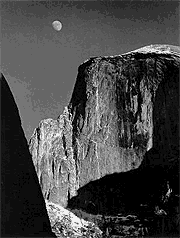
Moon and Half Dome, Yosemite National Park, California
Ansel Adams
photograph
1960 (American)

Sarah Bernhardt
Nadar (Felix Tournachon)
photograph
1859 (French)
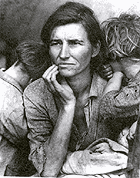
Migrant Mother
Dorothea Lange
photograph
1936 (American WPA)
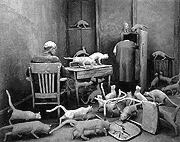
Radioactive Cats
Sandy Skoglund
photograph
1980 (American)
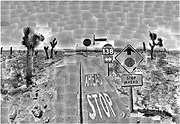
Pearblossom Highway
David Hockney
photograph
1986 (American)
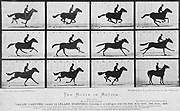
Galloping Horse
Eadweard Muybridge
photograph
1878 (English)
|
Chapter 8: Imaging: Photography, Film, Video, and Digital Arts
Photography
is the process of using light to create an image. An image is created when a light sensitive material is exposed for a limited time, then stabilized so that the image can be seen in daylight.
Ansel Adams
Alfred Stieglitz
- CAMERAS
- aperature is the size of the opening that allows light in. Most cameras can set the aperature to many different sizes. This is called the f-stop.
- shutter speed also helps to determine the length of exposure for the film
- FILM
is often made of an emulsion containing silver halide salts. The image is made when this film is exposed to light. This results in a negative, which then must be used to transfer the image to a print, or finished photgraph. Color film uses the primary colors in the photgraphic process.
- DIGITAL PHOTOGRAPHY
uses electronnic photosensitive chips to capture an image. All digital cameras use 256 values of gray at the core of their matrix. Each of those may be subdivied into a large array of colors depending on the number of bits or range of color.
- HISTORY OF PHOTOGRAPHY
- camera obscura was literally a "dark box" that was large enough for an artist to get inside of. An image was projected on the back wall by opening a small pinhole in the front. Then the artist would use it to draw a scene.
- photosensitive surfaces were first discovered by Heinriche Schulze in 1727 while he experimented with silver salts. In 1802, Thomas Wedgewood found that an image could be created on a piece of silver nitrate-soaked paper.
- heliography was invented in 1826 by Joseph-Nic»phore Niepce when he used bitumen and lavender oil to fix an image on a pewter plate.
- daguerreotype came out of a partnership between Niepce and Louis-Jacques-Mand» Daguerre. Daguerre's innovation used a sheet of silver-plated copper to fix an image through the use of a camera obscura. Initially, daguerreotypes were limited because an exposure had to take place over a period of 5 to 40 minutes but the process was improved to the point where the image could be created in 30-60 seconds of exposure time.
- negative invented in 1839 by William Henry Fox Talbot who found that sensitized paper that had been coated with an emulsion could accept photographic images. He later developed the contact print from this discovery.
- portraits early portrait photographers included Nadar (Felix Tournachon).
- photojournalism/photodocumentary began during the American Civil War with a photographer named Matthew Brady who was hired by the U. S. government to chronicle the war. During the Great Depression, the photographer Dorothea Lange was hired to document the effects of the Depression through a project called the WPA (Works Projects Administration).
- as an art form photography was not immediately accepted as an art form, but through advancements in the aesthetic character, the medium has become accepted as a viable art form. The work of Sandy Skoglund and David Hockney shows us just how far photography has come as an art form.
Cinematography
- VARIETIES OF CINEMATOGRAPHIC TECHNIQUES
stroboscopic motion is the illusion of motion created when a sequence of images are shown quickly. Eadweard Muybridge first employed this technique using a tool called a zoogyroscope. Cinematographic techniques include Fixed Camera (where the camera is set on a certain point), Mobile Camera (the camera is moved to different vantage points), editing (a technique invented by D. W. Griffith where segments are subtracted and added to the film), color, animation and special effects.
- VARIETIES OF CINEMATOGRAPHIC EXPERIENCE
The varieties of ways that movies communiate to us include Propaganda, Satire, Social Commentary, Fantasy, and Symbolism.
Video
Nam June Paik is a pioneer in video art. His sculptural video presentations look at pop culture and use elements from a wide variety of sources.
Digital Art
Digital art has manifested itself in 3-D graphics and other computer-based applications. An example of a digitally-produced animation and a 3-D graphic.
Chapter 9
| |
|
